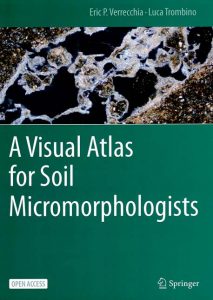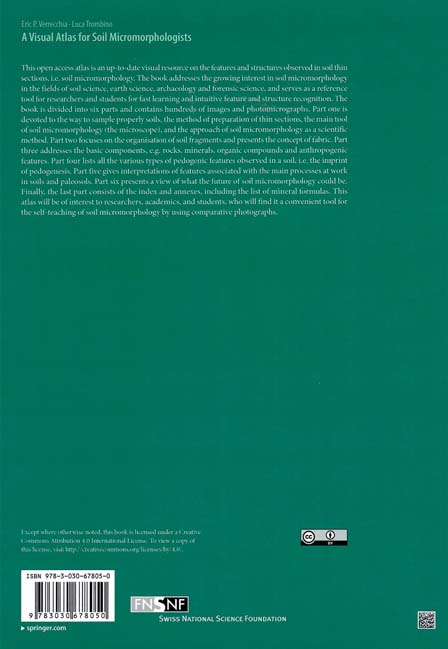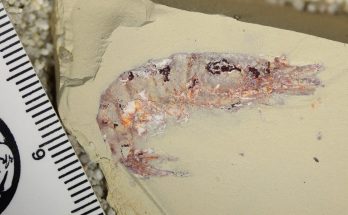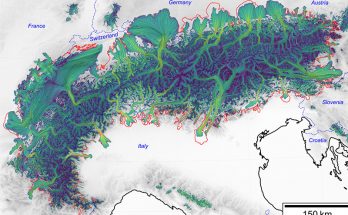Cette publication est également disponible en :
![]() Français
Français
If you want to learn about the innermost nature of soils, discover the new Atlas of Soil Micromorphology that has just been published.
This reference book has been published in Open access by Professor Eric Verrecchia (Institute of Earth Surface Dynamics) and his colleague Luca Trombino (University of Milan).
Eric Verrecchia, at the beginning of the academic year you will publish with your colleague Prof. Luca Trombino, a visual atlas of micromorphology (at Springer-Nature). What is it about?
The Visual Atlas for Soil Micromorphologists is based on the principle of natural science atlases, whether in petrology, histology, botany, etc. In this one, the idea is to present concepts, objects and characteristics that are commonly observed in soils at the microscopic scale. There were no such book existing until now, and it seemed appropriate to write this atlas, because we had noticed during our soil micromorphology classes that our students obviously lacked this information. This atlas is therefore useful as a learning support, but also as a quick reference when a specific question arises about a particular feature.
You have chosen to publish in Open Access. This is quite rare for this kind of book, especially at Springer. Why did you do so?
We did this work during our research activities, which means that during that time we were receiving a salary as professors. So not receiving royalties seemed legitimate since we are already paid to do this kind of work for the community. However, we had to pay the publisher to make the book available for free in digital format. In this case, we were fully supported by the SNSF (Swiss National Science Foundation) which we thank very much – the SNSF logo appears on the back cover so that people would know. During our numerous working sessions, the International Relations Departement of UNIL, the FGSE, as well as the Herbette Foundation made sure that the conditions of realization were as optimal as possible. In short, we were very well supported. Furthermore, we also thought of the numerous international students, in particular in developing countries, who will thus have free access to a basic work for the description of soils at the microscopic scale.
SNSF financial support for the Gold Road
The SNSF finances the publication of scientific books that are directly accessible, free of charge and without restriction in digital form (“gold road”).
Monographs and refereed collective works are financed, whether or not they are the result of an SNSF-supported project. The SNSF reimburses editorial services for quality control, production and distribution of books in the form of a Book Processing Charge (BPC).
Researchers can publish a printed book in parallel to the digital version in OA.
The Open Access website provides detailed information on the SNSF funding offer and on OA in general.
Is this discipline so widespread?
Actually, yes, micromorphology is one of the essential steps in the investigation of soils dynamics, these fragile interfaces that are so fundamental because they feed us, clean our water and contribute to the climate machinery, among other things. To understand the complex evolution of soils, it is necessary to observe their constituents and their interrelationships. This recent discipline, born in the 1930s, has not ceased to evolve and improve since then. We devote a small section to what it could be in the future. Finally, it is an essential discipline for deciphering the intimate transformations of our landscapes: taking a sample in the field and going directly to complicated laboratory analyses too often leads to biased functional interpretations. Addressing complexity requires multiscalar approaches, i.e. at different scales, each of which brings its own set of complementary information.
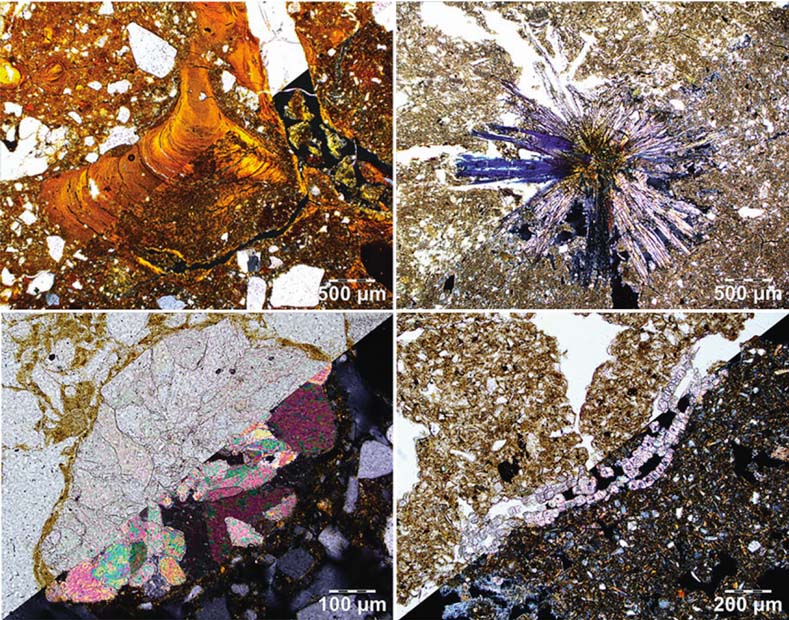
Top left: clay deposit in a brown soil (Italy). Top right: vivianite crystals in a soil disturbed by human activity (Italy). Bottom left: calcite granules of earthworms in a calcareous soil (Switzerland). Bottom right: calcified plant cells in a brown soil on loess (China).
So the need is real. It seems that it has already been a success…
Yes, we were very surprised. After two days there were 30,000 downloads and by the fourth day over 45,000. Our publisher was also very positively surprised, because today we have more than 150,000 downloads. So there was obviously a gap in this area.
Let’s go back to the content. Is this atlas intended for everyone?
It is a technical work. Micromorphology makes it possible to observe soils at scales ranging from centimeters to tens of thousands of millimeters. It therefore calls for enlightened notions of mineralogy and soil science in order to identify objects and processes, and to make hypotheses on the dynamics of the observed soil. Nevertheless, it is clear that within the FGSE itself, this Atlas can serve as an illustrative basis for the pedology courses of my colleague Dr. Stéphanie Grand, as well as for bachelor’s degree work on soils and for some geologists interested in paleosols; but the most interested audience will undoubtedly be that of master’s degree students in Biogeosciences, where this discipline is taught and practiced during the realization of their theses. I would also like to point out that some of the images are so beautiful and surprising that I am sure that the Atlas could also inspire artists or simple people curious about what is under their feet during their walks in nature!
Thank you Prof. Verrecchia and we wish long life and multiple reissues to this superb atlas.
Thanks to you.
Publisher Summary
This open access atlas is an up-to-date visual resource on the features and structures observed in soil thin sections, i.e. soil micromorphology. The book addresses the growing interest in soil micromorphology in the fieldsof soil science, earth science, archaeology and forensic science, and serves as a reference tool for researchers and students for fast learning and intuitive feature and structure recognition. The book is divided into six parts and contains hundreds of images and photomicrographs. Part one is devoted to the way to sample properly soils, the method of preparation of thin sections, the main tool of soil micromorphology (the microscope), and the approach of soil micromorphology as a scientific method. Part two focuses on the organization of soil fragments and presents the concept of fabric. Part three addresses the basic components, e.g. rocks, minerals, organic compounds and anthropogenic features. Part four lists all the various types of pedogenic features observed in a soil, i.e.the imprint of pedogenesis. Part five gives interpretations of features associated with the main processes at work in soils and paleosols. Part six presents a view of what the future of soil micromorphology could be. Finally, the last part consists of the index and annexes, including the list of mineral formulas. This atlas will be of interest to researchers, academics, and students, who will find it a convenient tool for the self-teaching of soil micromorphology by using comparative photographs..
Reference
Verrecchia E.P. and Trombino L. (2021) A Visual Atlas for Soil Micromorphologists, Springer-Nature, New-York, 196 pp. doi:10.1007/978-3-030-67806-7

